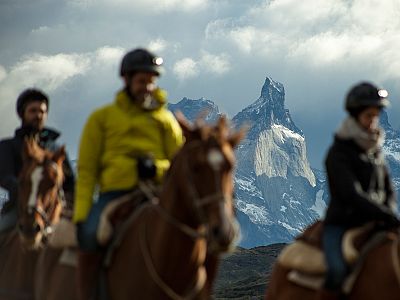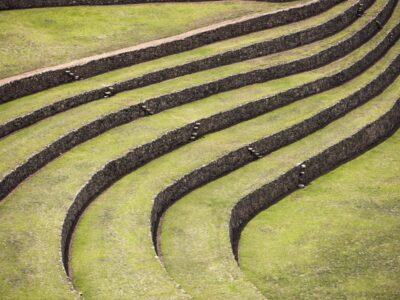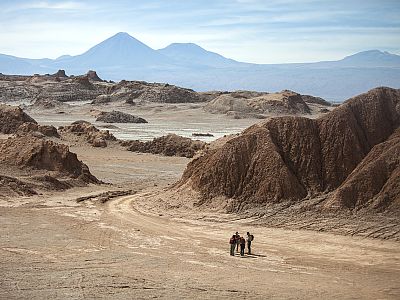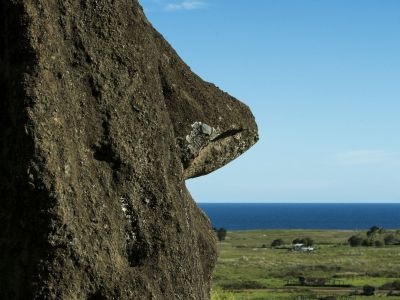Puritama Conservation Reserve
Located deep in the Andean canyons of the Atacama desert, this Explora Reserve covers a unique ecoregion in the world, where the Andes Altiplano and the driest desert in the world converge on the Great Atacama Salt Lake.
The reserves cover an area of 7.000 ha within the Puritama River Valley, including the Puritama hot springs, where the native vegetation and the abundance of flora and fauna offer an oasis for numerous species. There, from 2010 explora carries out the most prolonged monitoring of the endangered Andean cat (gato Andino), among conservations efforts of other iconic species, crucial for this diverse ecosystem, such as puma, pampas cat, foxes, dozens of birds ranging from the majestic Chilean Blue Eagle up to the tiny greenish-yellow finch, and even some new-for-the-science species of lizard and frog.
Over the last decades, our engagement with Altiplano and Atacama reinforced our care for their territory and the people who belong and visit them. Their unique landscapes, exceptional ecosystems, and living ancestral cultures are a world’s heritage that only sustainable conservation will preserve for present and future generations. Puritama Conservation Reserve is conceived to bring people together to support and participate in a wide range of conservation projects.
Place map
Located 60 km north of the town of San Pedro de Atacama, Puritama’s Conservation Reserve extends as an oasis of water and vegetation along the Puritama River’s course from the Altiplano to the Atacama Desert, the driest place on earth.
The reserve’s conservation and influence area extends for hundreds of kilometers, from the Andes high plateau, home to flora, wildlife and people who adapted to live over 15.000 feet high, such as Quechua and Aymara cultures, to the Atacama Desert, where water is extremely scarce, and the land receives the highest recorded radiation from the sun.
We invite you to learn more about this project here.
Hectares
Of territory protected and focused on developing sustainable tourism with an emphasis on the natural and cultural heritage of Atacama.Hotspring pools
the reserve is home to ancient hot springs which water temperature remains at 28° to 31° C with an important concentration of minerals.Flora species
The reserve accounts for a wide range of flora considering it is located in the middle of the driest desert in the world.Fauna species
The reserve is home to a variety of birds, insects and animals among which is the Andean Cat; and iconic and endangered species monitored by Explora since 2010.PURITAMA CONSERVATION RESERVE
Serving its millenary role as an oasis for plants, animals and humans, Puritama's Reserve offers a unique area to explore and conserve. The river gently runs down through the fertile canyon, forming terraces of hot springs, where travelers and visitors can hike, learn and participate in conservation projects in close contact with local ancestral communities.
-
As philanthropy often fades in the long run, we start a venture that joins the virtues of business enterprise and non-profit commitment. The design enables us to expand and accelerate conservation as well as project it in perpetuity.
The reserves’ territory retains 95% of its area only to exploration and conservation, while the remaining 5% is subject to developments that include tourism, real state, research, and education.
Serving its millenary role as an oasis for both animals and humans, Puritama’s Reserve offers a unique area to explore and relax. The river gently runs down through the fertile canyon, forming terraces of hot springs, where travelers and visitors can indulge themselves after hiking. The Reserve will host a Conservation Center designed to be a meeting point for park rangers, guides, volunteers, owners, travelers, and researchers. It is ment to be a living space where visitors can
learn about nature, history, and conservation projects -and their results-, in close contact with local communities and the testimonies of their old way of life.A wide range of explorations will be available: both led by our guides with their distinctive training and knowledge, along with self-guided trails with exploration and conservation content supported by technology.
We welcome you all to explore and conserve the world unique. We invite you to join our Reserves, where you can participate as an owner, traveler, researcher, visitor, volunteer, or intern. We welcome you all, to explore and conserve the world unique.
We invite you to learn more about this project here.


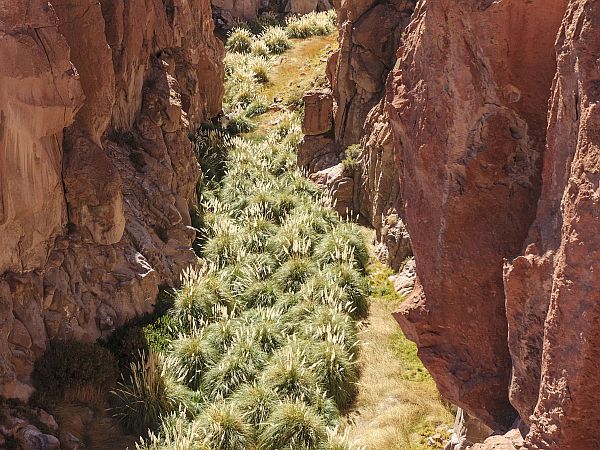
-
The Puritama Conservation Reserve is located approximately 60 km north of the town of San Pedro de Atacama between the Altiplano and the Atacama Desert of the Antofagasta Region.
It is an oasis in one of the world’s aridest regions, where water could be extremely scarce and the land received one of the sun’s highest radiations recorded on earth.
Almost in their entirety, the Puritama and Puripica ravines are part of the intermediate gorges of the rhyolitic plateau ecozone. In Puritama, however, the narrow route connecting to the Jorquencal ravine establishes a direct connection with the high puna.
The Puritama River originates from a geothermal source near the center of the reserve, feeding into the Puritama hot springs. The area also includes part of the Puripica River, which converges with the Puritama River near Guatín. The area has a marginal, high altitude climate with low relative humidity and wide-ranging temperatures from day to night. Between July and August, the rivers freeze at night and thaw during the day. They swell from tropical rains during the austral summer months, mainly between January and March. Also, strong southwest winds can reach 100 km/h. The winds, which are especially strong between September and November, carry fine sediment and are a significant force of erosion.

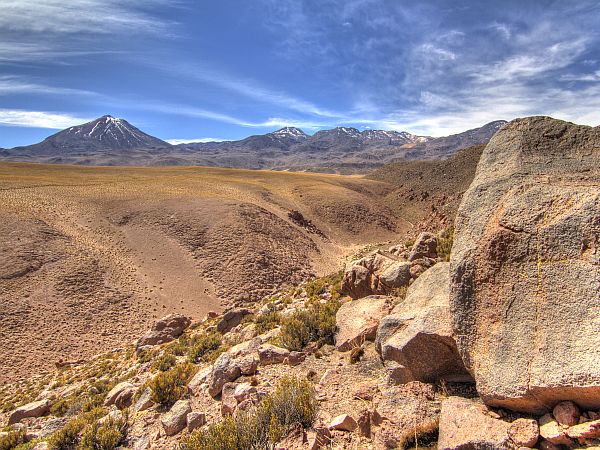
-
The geographical conditions serve as a biological advantage, giving life to many species of the Andean Region.
Flora: The geographical conditions serve as a biological advantage, giving life to many species of the Andean Region. The Reserve locates at an altitude ranging from 3,700 to 4,200 meters above sea level, affecting oxygen availability and solar radiation, which influences photosynthesis and plant growth. Within the Reserve, and specifically in the ravines, plants depend on the availability of water, minerals and solar energy for their development and growth. Puritama Conservation Reserve distinct conditions of topography, altitude, substrate type, and macro and microclimate influence the development, physiological and morphological adaptations of the flora. First, topography is heterogeneous, with as many flat areas as gentle hillsides and steep slopes from deep ravines. For example, in a single canyon, the directional exposure of a hill can create substantial differences in vegetation—the northern slope (in the southern hemisphere) is more likely to be drier due to receiving a higher amount of solar radiation. Therefore, the species inhabiting northern slopes, such as cacti, are better adapted to extreme dryness. Second, different types of substrates affect the availability of nutrients and, consequently, root development.
They photosynthesize more efficiently. To reduce excessive water loss, they have a smaller leaf surface and modified leaf structure—in some cases, leaves are entirely absent or replaced by spines, with photosynthesis occurring in the stem. Other species may develop a thick cuticle or scales on their leaves and stems to create a microclimate around the plant tissue and avoid desiccation. Others close their stomata during the day, keeping them open only at night. Seeds can develop a hard covering or contain substances that impede germination in adverse conditions. The arrival of rain is a signal to germinate and complete the plant’s biological cycle.
Fauna: The fauna of the Altiplano ecoregion is among the richest and most varied in the country. The Puritama Conservation Reserve is a faithful example of this richness, containing a high diversity of species, well-adapted to the extreme conditions of temperature and aridity in the area, making this Reserve a unique place. Because of its diverse environments, is home to many birds, with about the same number of diurnal species as nocturnal. Recent surveys detected nearly 30 species from 10 orders and 15 families. The order most represented is Passeriformes (songbirds) and its families of Thraupidae (yellow finches and sierra finches) with seven species, and Furnariidae (earth readers, tit-spinetail, etc.) with five species.
Also, amphibians and reptiles can be spotted mainly in the river and hot spring areas. The presence of lizards such as the Liolaemus constanzae is now joint by new species that we have temporarily given the name of Lioalemus puritamensis.
The Puritama study also identified many mammals, some of them thriving in this rich and diverse ecosystem. Many species of common rodents are present, as well as some signature animals of the region like the guanaco (Lama guanicoe,) zorro culpeo (Lycalopex culpaeus) and vizcacha ( Lagidium viscacia). Within the feline family, there’s a strong presence of puma (Puma Concolor) and, of course, the “sacred feline” Andean cat (Leopardus jacobita), one of the most important and recognizable endangered species of South America

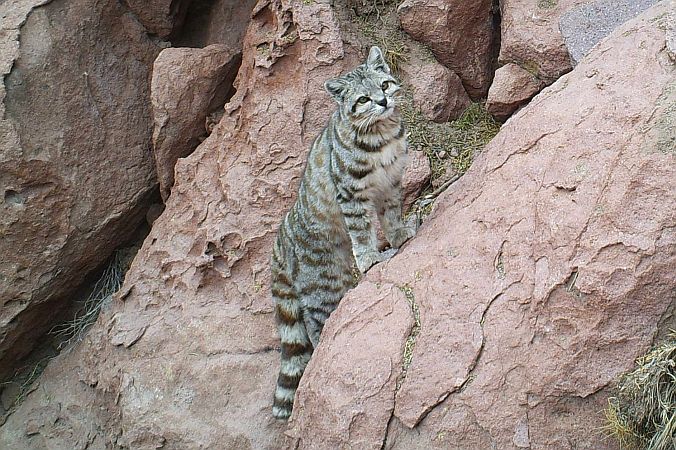
-
The study area belongs to Chile’s “Norte Grande” (Far North). Formed by diverse ecozones located at different altitudes, it has a different set of natural resources that complement each other. Indeed, the economic necessity to supplement available resources has been a driving force behind the human displacement and migration in this region. Therefore, understanding past and present populations require considering each ecozone by itself and concerning the others. In the high puna, the low temperatures offset higher precipitation to inhibit vegetation growth during winter, making plant resources available only during the summer months. Together these conditions have helped shape a pattern of human settlement in which populations concentrate in the intermediate rhyolitic plateau; the foothill oases and the vegas (wet meadows) found at the edges of the Salar de Atacama, and seasonally in more extreme ecozone levels.


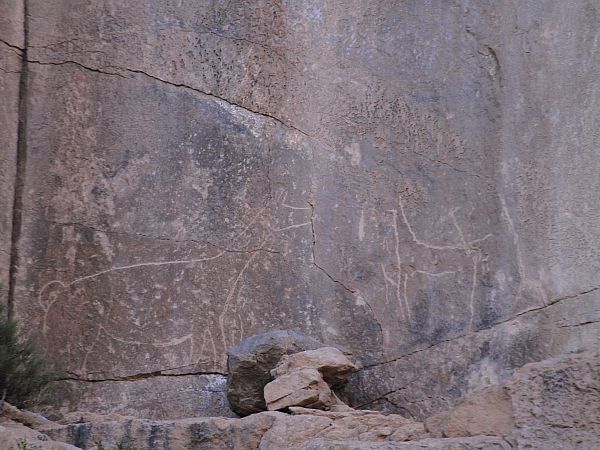
-
For the Atacama people—or likan-antai—the Kimal, Lascar, Licancabur and Juriques mountains are sacred; the volcanoes are men and the mountains are women.
Thousands of years ago, Licancabur fell in love with Kimal, and they married. However, Juriques—Licancabur’s younger brother—also fell in love with Kimal. He courted and pursued her for so long that Kimal finally surrendered to his charm. Betraying Licancabur, she loved Juriques in secret. Lascar, the father of both volcanoes and “great lord of the mountains”, discovered what was happening and punished Juriques for his betrayal by making his peak explode with a ball of fire, leaving him in his present form with a plateau for a top. Kimal received punishment by exile, confined over 100 km southward in the other extreme of Atacama’s salt flat. Today, is easy to see from San Pedro the upright Licancabur and the headless Juriques by his side, separated by a vast, barren flatland where Kimal should be. Instead, she is on the other side of the salt flat, crowning the Domeyko range with her majestic height.
However, every winter solstice, on June 29 in the early morning, Licancabur’s shadow stretches out more than 100 km and his cone touches Kimal’s peak, demonstrating his everlasting love despite the years and distance that separate them. This story of Lincancabur and Kimal —one of the most important myths of the region— is thought to be responsible for the fertility of the Atacama salt flat. The winter solstice also coincides with the celebration (since colonial times) of San Pedro, the patron saint of the town, as the end of one agricultural cycle and the beginning of a new one.

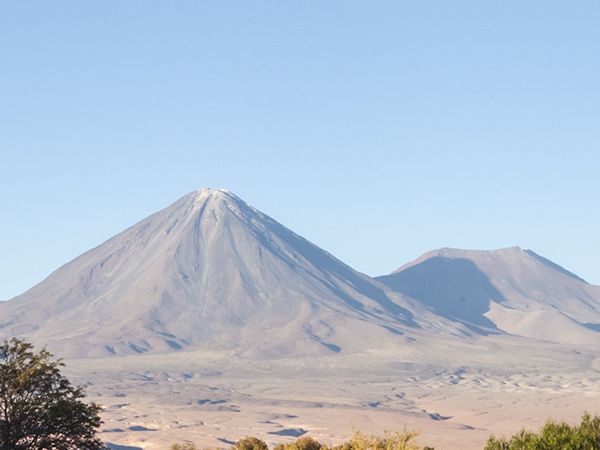
As philanthropy often fades in the long run, we start a venture that joins the virtues of business enterprise and non-profit commitment. The design enables us to expand and accelerate conservation as well as project it in perpetuity.
The reserves’ territory retains 95% of its area only to exploration and conservation, while the remaining 5% is subject to developments that include tourism, real state, research, and education.
Serving its millenary role as an oasis for both animals and humans, Puritama’s Reserve offers a unique area to explore and relax. The river gently runs down through the fertile canyon, forming terraces of hot springs, where travelers and visitors can indulge themselves after hiking. The Reserve will host a Conservation Center designed to be a meeting point for park rangers, guides, volunteers, owners, travelers, and researchers. It is ment to be a living space where visitors can
learn about nature, history, and conservation projects -and their results-, in close contact with local communities and the testimonies of their old way of life.
A wide range of explorations will be available: both led by our guides with their distinctive training and knowledge, along with self-guided trails with exploration and conservation content supported by technology.
We welcome you all to explore and conserve the world unique. We invite you to join our Reserves, where you can participate as an owner, traveler, researcher, visitor, volunteer, or intern. We welcome you all, to explore and conserve the world unique.
We invite you to learn more about this project here.



The Puritama Conservation Reserve is located approximately 60 km north of the town of San Pedro de Atacama between the Altiplano and the Atacama Desert of the Antofagasta Region.
It is an oasis in one of the world’s aridest regions, where water could be extremely scarce and the land received one of the sun’s highest radiations recorded on earth.
Almost in their entirety, the Puritama and Puripica ravines are part of the intermediate gorges of the rhyolitic plateau ecozone. In Puritama, however, the narrow route connecting to the Jorquencal ravine establishes a direct connection with the high puna.
The Puritama River originates from a geothermal source near the center of the reserve, feeding into the Puritama hot springs. The area also includes part of the Puripica River, which converges with the Puritama River near Guatín. The area has a marginal, high altitude climate with low relative humidity and wide-ranging temperatures from day to night. Between July and August, the rivers freeze at night and thaw during the day. They swell from tropical rains during the austral summer months, mainly between January and March. Also, strong southwest winds can reach 100 km/h. The winds, which are especially strong between September and November, carry fine sediment and are a significant force of erosion.



The geographical conditions serve as a biological advantage, giving life to many species of the Andean Region.
Flora: The geographical conditions serve as a biological advantage, giving life to many species of the Andean Region. The Reserve locates at an altitude ranging from 3,700 to 4,200 meters above sea level, affecting oxygen availability and solar radiation, which influences photosynthesis and plant growth. Within the Reserve, and specifically in the ravines, plants depend on the availability of water, minerals and solar energy for their development and growth. Puritama Conservation Reserve distinct conditions of topography, altitude, substrate type, and macro and microclimate influence the development, physiological and morphological adaptations of the flora. First, topography is heterogeneous, with as many flat areas as gentle hillsides and steep slopes from deep ravines. For example, in a single canyon, the directional exposure of a hill can create substantial differences in vegetation—the northern slope (in the southern hemisphere) is more likely to be drier due to receiving a higher amount of solar radiation. Therefore, the species inhabiting northern slopes, such as cacti, are better adapted to extreme dryness. Second, different types of substrates affect the availability of nutrients and, consequently, root development.



They photosynthesize more efficiently. To reduce excessive water loss, they have a smaller leaf surface and modified leaf structure—in some cases, leaves are entirely absent or replaced by spines, with photosynthesis occurring in the stem. Other species may develop a thick cuticle or scales on their leaves and stems to create a microclimate around the plant tissue and avoid desiccation. Others close their stomata during the day, keeping them open only at night. Seeds can develop a hard covering or contain substances that impede germination in adverse conditions. The arrival of rain is a signal to germinate and complete the plant’s biological cycle.
Fauna: The fauna of the Altiplano ecoregion is among the richest and most varied in the country. The Puritama Conservation Reserve is a faithful example of this richness, containing a high diversity of species, well-adapted to the extreme conditions of temperature and aridity in the area, making this Reserve a unique place. Because of its diverse environments, is home to many birds, with about the same number of diurnal species as nocturnal. Recent surveys detected nearly 30 species from 10 orders and 15 families. The order most represented is Passeriformes (songbirds) and its families of Thraupidae (yellow finches and sierra finches) with seven species, and Furnariidae (earth readers, tit-spinetail, etc.) with five species.
Also, amphibians and reptiles can be spotted mainly in the river and hot spring areas. The presence of lizards such as the Liolaemus constanzae is now joint by new species that we have temporarily given the name of Lioalemus puritamensis.
The Puritama study also identified many mammals, some of them thriving in this rich and diverse ecosystem. Many species of common rodents are present, as well as some signature animals of the region like the guanaco (Lama guanicoe,) zorro culpeo (Lycalopex culpaeus) and vizcacha ( Lagidium viscacia). Within the feline family, there’s a strong presence of puma (Puma Concolor) and, of course, the “sacred feline” Andean cat (Leopardus jacobita), one of the most important and recognizable endangered species of South America
The study area belongs to Chile’s “Norte Grande” (Far North). Formed by diverse ecozones located at different altitudes, it has a different set of natural resources that complement each other. Indeed, the economic necessity to supplement available resources has been a driving force behind the human displacement and migration in this region. Therefore, understanding past and present populations require considering each ecozone by itself and concerning the others. In the high puna, the low temperatures offset higher precipitation to inhibit vegetation growth during winter, making plant resources available only during the summer months. Together these conditions have helped shape a pattern of human settlement in which populations concentrate in the intermediate rhyolitic plateau; the foothill oases and the vegas (wet meadows) found at the edges of the Salar de Atacama, and seasonally in more extreme ecozone levels.



For the Atacama people—or likan-antai—the Kimal, Lascar, Licancabur and Juriques mountains are sacred; the volcanoes are men and the mountains are women.
Thousands of years ago, Licancabur fell in love with Kimal, and they married. However, Juriques—Licancabur’s younger brother—also fell in love with Kimal. He courted and pursued her for so long that Kimal finally surrendered to his charm. Betraying Licancabur, she loved Juriques in secret. Lascar, the father of both volcanoes and “great lord of the mountains”, discovered what was happening and punished Juriques for his betrayal by making his peak explode with a ball of fire, leaving him in his present form with a plateau for a top. Kimal received punishment by exile, confined over 100 km southward in the other extreme of Atacama’s salt flat. Today, is easy to see from San Pedro the upright Licancabur and the headless Juriques by his side, separated by a vast, barren flatland where Kimal should be. Instead, she is on the other side of the salt flat, crowning the Domeyko range with her majestic height.
However, every winter solstice, on June 29 in the early morning, Licancabur’s shadow stretches out more than 100 km and his cone touches Kimal’s peak, demonstrating his everlasting love despite the years and distance that separate them. This story of Lincancabur and Kimal —one of the most important myths of the region— is thought to be responsible for the fertility of the Atacama salt flat. The winter solstice also coincides with the celebration (since colonial times) of San Pedro, the patron saint of the town, as the end of one agricultural cycle and the beginning of a new one.



Discover Our Destinations
Endless revelations and possibilities await.
